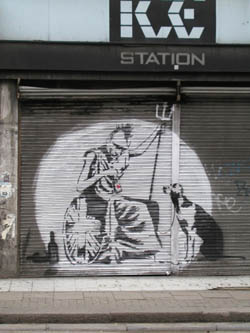
Mayday Festival London - Walk Radical
Seamus O Conner steps out with the Deptford mob for the first of the Mayday Festival of Alternatives' events in south London.
27th April 2002
The first of the Mayday Alt Fez events was a sodden but momentously symbolic affair.
First there was the struggle; pouring rain, yapping dogs, incessant traffic and heckling drunks.
Secondly there was the triumph. All 50 of the diverse collection who turned up for the New Cross and Deptford Radical Walk on April 27 braved it to the end.
Thirdly, and particularly apt, the hardy assemblage learned that a song sung at thousands of Mayday events across the world for many generations was in fact written in New Cross.
In 1889 an Irish ex-docker called Jim Connell was keen to commemorate both an ongoing dock strike and the martyrdom of several Chicago anarchists earlier that year. So, whilst sitting on a train at New Cross Gate, he wrote "We'll keep the red flag flying here".
The Strawberry Thieves Socialist Choir battled with roaring traffic on New Cross Road to give us a rendition, whilst a lager-soaked royalist 'Ingerland' fan tried, unsuccessfully, to pick a fight with "you call yerself fucking anarchists".
But it was worse for the Deptford Labour Choir in 1936. After singing the song at a huge rally in the New Cross Empire held during the general strike, they left the building only to be baton-charged by the police. Forty years later (1977) the first ever use of police riot shields occurred in New Cross as police tried to stop anti-fascists chasing a mess of National Front supporters.
The longer the walk progressed the more we came to realise just how deep goes the history which doesn't make it into the school books. As we wound our way round New Cross we learnt of the bread riots of 1867 when the working class of Deptford decided enough was enough and helped themselves to the bread when the high price made a luxury out of a staple.
We also heard how local sailors, fed up by being press ganged and poorly paid by the Royal Navy at Greenwich, rebelled in 1774. When five of them were imprisoned at Deptford Broadway, 2000 sailors marched on the jail released the prisoners and burnt the jail down.
The inauspicious side of local history was pointed out when we stood infront of the stone statue of Sir Francis Drake on Deptford Town Hall. Our guide reminded us of how Drake made several trips out of Deptford to collect slaves in Africa. And how Oliver Cromwell packed slaves on ships sailing from Deptford to the Caribbean.
However, the area stood up for itself. The first ever multi-racial wedding in Britain occurred at St Nicholas Church in Deptford in the early part of the twentieth century and the churchyard hosts many graves of black sailors. Decades later, a racist fire bomb attack killed 13 people at a party at New Cross in 1981. When thousands of black people held an anti-racist demonstration, The Sun ran the story with the headline: "The day the black's ran riot in London."
The working class and ethnic communities of south London were particularly viewed as lowlife by the establishment. In the 1800's the "roughs from Deptford", as they were referred to, were the equivalent to the modern day "hardcore element"; cited by press and police alike as central troublemakers in any London demonstration. In 1886, as a demonstration of unemployed people was about to take place on Trafalgar Square, the Times reported that the "Deptford mob" were amassing in their thousands ready to reap havoc on north London. The story, not unusually, was complete fiction.
In 1887 the Times referred to the "south London radicals and agitators", once again accusing the "choice spirits from Battersea to Greenwich" of stirring up trouble amongst the working class.
Ah how times don't change!
A Jack on the Green Festival organised by Deptford chimney sweeps and taking place on Mayday in the early 1900's was suppressed by police. The Fordham Park Festival, London's largest one day free festival was stopped by the local council in 1996 after its increasing cultural popularity co-incided with the Criminal Justice and Public Order Act.
Appropriately enough the Mayday Radical Walk ended in a sprawl of luxury housing which has shot up on the water front at Deptford over the last year. The old warehouses and flour mills have been torn down and, in their place, blocks of one bedroom flats "with river views" are now selling for £300,000 each. After decades of being kept at bay by the roughs of Deptford, the nouveau riche are now pouring in and a sterile gentrification is well under way.
In the courtyard of Grenfill Mansions a coil of black anchor chain has been cleaned, painted and left in place to give the wealthy invaders some sense of the working class past; a lip service to a place where real communities once lived, grafted, marched and gave birth. Their modern day council estate equivalents are not so slowly and surely being forced/seduced out by escalating house prices.
So, it seemed appropriate then that the two yapping dogs which had followed us for the whole walk - fighting, barking and generally getting in the way - had the final say. The black and white mongrel clamped his teeth around a small ornamental tree in the twee garden outside Grenfill Mansions and trotted off with it; the tree's shallow and insubstantial root system offering no resistance. His mongrel mate, seeing that it was time to go, dropped a dump on the manicured lawn and padded after him.
Neil Starman, is a committed social historian who produces Practical History pamphlets charting radical local histories.
He can be contacted on practicalhistory@hotmail.com
